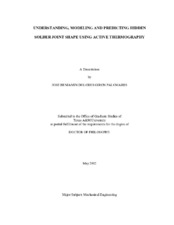| dc.contributor.advisor | Hsieh, Sheng-Jen | |
| dc.creator | Giron Palomares, Jose | |
| dc.date.accessioned | 2012-07-16T15:58:53Z | |
| dc.date.accessioned | 2012-07-16T20:29:39Z | |
| dc.date.available | 2014-09-16T07:28:20Z | |
| dc.date.created | 2012-05 | |
| dc.date.issued | 2012-07-16 | |
| dc.date.submitted | May 2012 | |
| dc.identifier.uri | https://hdl.handle.net/1969.1/ETD-TAMU-2012-05-11223 | |
| dc.description.abstract | Characterizing hidden solder joint shapes is essential for electronics reliability. Active thermography is a methodology to identify hidden defects inside an object by means of surface abnormal thermal response after applying a heat flux. This research focused on understanding, modeling, and predicting hidden solder joint shapes. An experimental model based on active thermography was used to understand how the solder joint shapes affect the surface thermal response (grand average cooling rate or GACR) of electronic multi cover PCB assemblies. Next, a numerical model simulated the active thermography technique, investigated technique limitations and extended technique applicability to characterize hidden solder joint shapes. Finally, a prediction model determined the optimum active thermography conditions to achieve an adequate hidden solder joint shape characterization.
The experimental model determined that solder joint shape plays a higher role for visible than for hidden solder joints in the GACR; however, a MANOVA analysis proved that hidden solder joint shapes are significantly different when describe by the GACR. An artificial neural networks classifier proved that the distances between experimental solder joint shapes GACR must be larger than 0.12 to achieve 85% of accuracy classifying. The numerical model achieved minimum agreements of 95.27% and 86.64%, with the experimental temperatures and GACRs at the center of the PCB assembly top cover, respectively. The parametric analysis proved that solder joint shape discriminability is directly proportional to heat flux, but inversely proportional to covers number and heating time. In addition, the parametric analysis determined that active thermography is limited to five covers to discriminate among hidden solder joint shapes. A prediction model was developed based on the parametric numerical data to determine the appropriate amount of energy to discriminate among solder joint shapes for up to five covers. The degree of agreement between the prediction model and the experimental model was determined to be within a 90.6% for one and two covers. The prediction model is limited to only three solder joints, but these research principles can be applied to generate more realistic prediction models for large scale electronic assemblies like ball grid array assemblies having as much as 600 solder joints. | en |
| dc.format.mimetype | application/pdf | |
| dc.language.iso | en_US | |
| dc.subject | active thermography | en |
| dc.subject | hidden solder joint | en |
| dc.subject | FEA | en |
| dc.subject | multi PCB assemblies | en |
| dc.subject | nondestructive evaluation | en |
| dc.subject | parametric analysis | en |
| dc.subject | artificial neural networks | en |
| dc.title | Understanding, Modeling and Predicting Hidden Solder Joint Shape Using Active Thermography | en |
| dc.type | Thesis | en |
| thesis.degree.department | Mechanical Engineering | en |
| thesis.degree.discipline | Mechanical Engineering | en |
| thesis.degree.grantor | Texas A&M University | en |
| thesis.degree.name | Doctor of Philosophy | en |
| thesis.degree.level | Doctoral | en |
| dc.contributor.committeeMember | Alvarado, Jorge | |
| dc.contributor.committeeMember | Han, Je-Chin | |
| dc.contributor.committeeMember | Suh, Chii-Der | |
| dc.type.genre | thesis | en |
| dc.type.material | text | en |
| local.embargo.terms | 2014-07-16 | |


